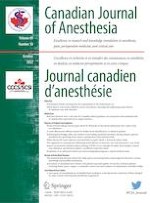Published in:

29-07-2022 | Septic Shock | Reports of Original Investigations
White blood cell count trajectory and mortality in septic shock: a historical cohort study
Authors:
Emily Rimmer, MD, MSc, Allan Garland, MD, MA, Anand Kumar, MD, Steve Doucette, MSc, Brett L. Houston, MD, Chantalle E. Menard, MD, Murdoch Leeies, MD, Alexis F. Turgeon, MD, MSc, Salah Mahmud, MD, PhD, Donald S. Houston, MD, PhD, Ryan Zarychanski, MD, MSc
Published in:
Canadian Journal of Anesthesia/Journal canadien d'anesthésie
|
Issue 10/2022
Login to get access
Abstract
Purpose
Septic shock is associated with a mortality of 20–40%. The white blood cell count (WBC) at hospital admission correlates with prognosis in septic shock. Here, we explore whether the trajectory of WBC after admission provides further information about outcomes. We aimed to identify groups of patients with different WBC trajectories and the association of WBC trajectory with mortality.
Methods
We included adult patients with septic shock in two academic intensive care units (ICU) in Winnipeg, MB, Canada between 2006 and 2012. We used group-based trajectory analysis to group patients according to their WBC patterns over the first seven days in the ICU. Our primary analysis was the association of WBC trajectory group on 30-day mortality using multivariable Cox proportional hazards regression.
Results
We included 917 patients with septic shock. The final model identified seven distinct WBC trajectories. The rising WBC trajectory was independently associated with increased mortality (hazard ratio, 3.41; 95% confidence interval, 1.86 to 6.26; P < 0.001) compared with the stable WBC trajectory.
Conclusion
In patients with septic shock, distinct and clinically relevant groups can be identified by analyzing WBC trajectories. A rising WBC trajectory was associated with higher mortality.





